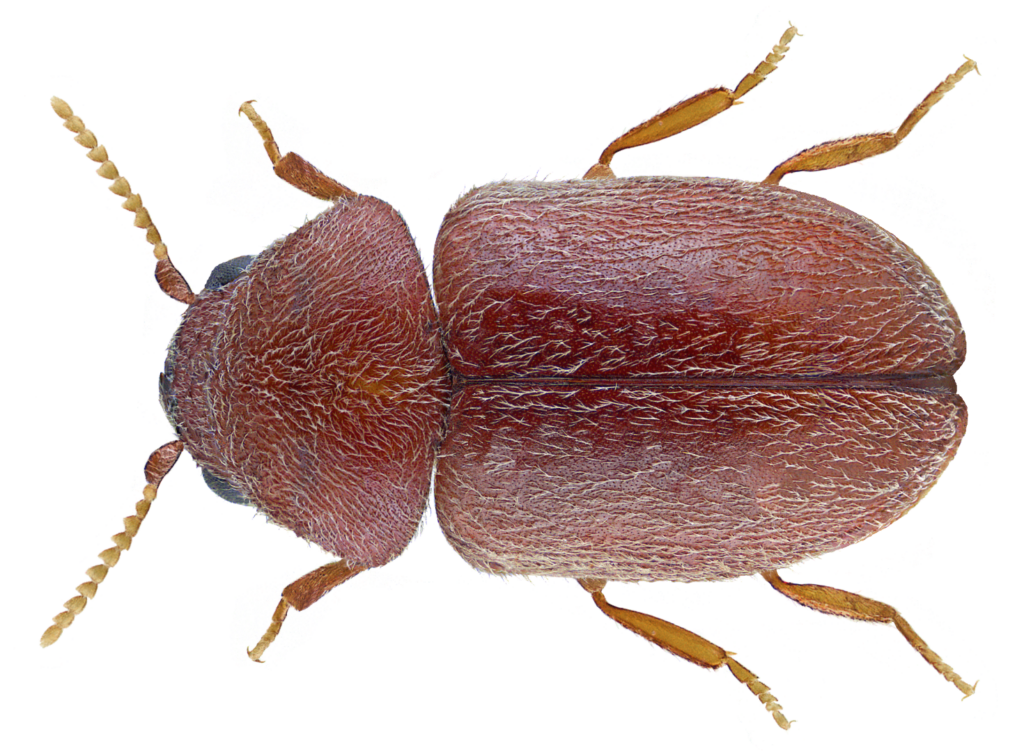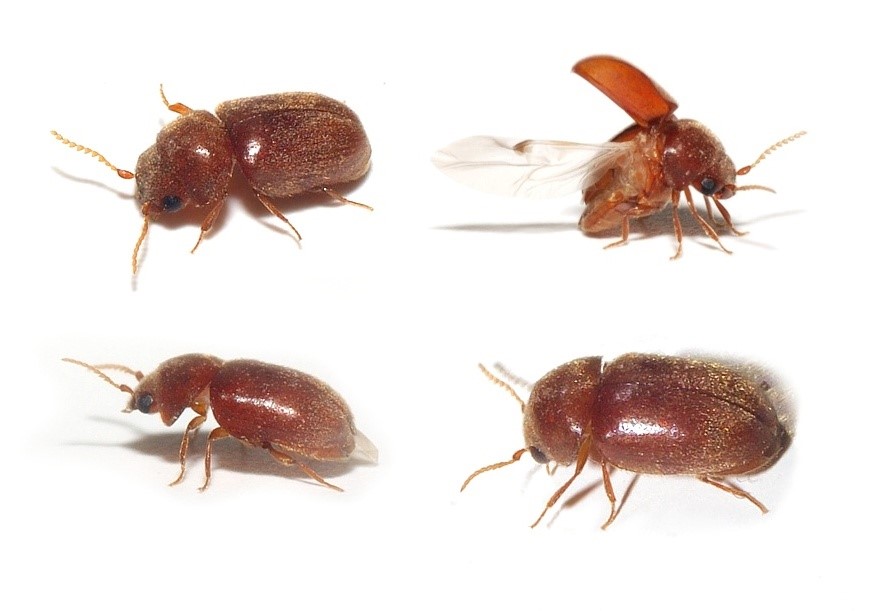Tobacco Beetles
What is a Tobacco Beetle?
A tobacco beetle is a small beetle from the family Anobiidae. It is best known for damaging tobacco products but is not limited to them. Tobacco beetle larvae can attack a wide variety of stored dry goods, including cereals and spices. This insect is particularly problematic in food storage areas and libraries, where it can damage books and other organic materials.
How to Identify Tobacco Beetles?
Tobacco beetles, with their modest size of 2 to 3 mm in length, have a distinctive oval body tinged with reddish-brown, making these insects particularly recognizable by their slightly inclined head under the body, reminiscent of a small violin. This unique characteristic, along with their feeding method, results in small holes in packaging and infested products, an early warning sign of an infestation.
The discovery of larvae accompanied by piles of fine dust, waste from their consumption, highlights the activity of these pests. When these signs become apparent, they not only indicate the active presence of tobacco beetles but also the potential level of damage they can inflict on stored goods, emphasizing the importance of quick intervention to limit their proliferation and associated damage.

Additional Information on Tobacco Beetles
Pest Type
Insect. Tobacco beetles are beetles that pose a significant risk to warehouses, libraries, and homes due to their ability to degrade a wide variety of organic products.
Appearance
With their small, oval bodies, reddish-brown color, and size of 2-3 mm, they are easily identifiable by specialists but can go unnoticed by the uninitiated until damage is discovered.
Lifespan
Varies depending on environmental conditions, with a life cycle that can extend over several months, allowing infestations to develop rapidly if not controlled.
Habitat
They favor storage areas such as food warehouses and pantries, where they have easy access to their food source.
Diet
Their diet includes not only tobacco products but also a variety of stored dry goods, making many domestic and commercial environments vulnerable to their presence.
Life Cycle
The tobacco beetle’s life cycle, from egg to adult, promotes rapid multiplication, requiring effective preventive and curative actions. Females lay eggs in hiding places near food sources, larvae cause damage by feeding, before transforming into adults, thus repeating the cycle.
Do I Have a Tobacco Beetle Problem?
The discovery of small holes in the packaging of stored products is a clear indicator of tobacco beetle activity. These holes are often the result of larvae feeding, which, upon emerging, leave these distinctive marks behind.
Finding larvae and fine dust in or around the attacked products. This dust, which is actually larval excrement, can often be found accumulated near infested products or on shelves.
Observing adult beetles flying around light sources indicates not only the active presence of these pests but also the maturity of the infestation, necessitating immediate action to limit their spread and prevent further damage.
Signs of a Tobacco Beetle Infestation
- Material Damage: Tobacco beetles are particularly known for their gnawing habits, which can lead to significant damage to various stored goods.
- Presence: Scratching, movement, or activity noises in attics, walls, or other structural parts of the house, especially during the day, are telltale signs of their presence.
- Larvae and Pupae: Finding larvae accompanied by piles of fine dust, waste from their consumption, highlights the activity of these pests.
- Excrement: The discovery of fine dust around infested products or shelves, indicating larval excrement.


Risks Associated with Tobacco Beetles
While tobacco beetles are not directly associated with the transmission of diseases, their ability to cause considerable damage to stored goods should not be underestimated. Their penchant for tobacco products, as well as for a variety of other stored organic materials, can lead to significant economic losses for businesses and individuals. These pests can quickly turn valuable products into irrecoverable losses, emphasizing the need for preventive and reactive action.
Exterminapro stands ready to offer professional extermination solutions tailored to the extent of the infestation, ensuring the protection of your belongings and the preservation of your peace of mind against the threat posed by tobacco beetles.
Treatments to Get Rid of Tobacco Beetles
Preventing Tobacco Beetle Infestations
- Proper Storage: Storing susceptible products in airtight containers is a key preventive measure. By limiting tobacco beetles’ access to their food source, you significantly reduce the risk of infestation. This simple step can greatly contribute to the protection of your stored products, ranging from tobacco leaves to cereals and spices.
- Regular Inspection: Regularly inspecting storage areas for any suspicious activity is essential for effective prevention. Constant vigilance allows for the early detection of infestation signs, such as larvae, fine dust resulting from their feeding, or flying adults, facilitating quick intervention before the problem worsens.
Types of Treatments to Control Tobacco Beetles
- Targeted Traps and Insecticides: The use of specific traps and targeted insecticides is a doubly effective approach to combat tobacco beetle infestations. Traps attract insects using pheromones or other baits, while targeted insecticides treat specifically infested areas without damaging unaffected products. This method ensures a rapid reduction in the pest population.
- Professional Interventions: Professional interventions are crucial for accurately diagnosing the extent of the infestation and identifying potential breeding sites. By eliminating sources of infestation using proven techniques, Exterminapro guarantees complete and lasting eradication while implementing strategies to prevent future recurrences, ensuring long-term protection of your belongings.
How to Permanently Eradicate Tobacco Beetles?
With Exterminapro, benefit from a professional approach for the complete elimination of tobacco beetles, ensuring peace of mind in your daily environment.
Intervention Process
How Much Does It Cost?
Get a Free Estimate
The cost of exterminating tobacco beetles depends on the extent of the infestation and the necessary treatment methods. Exterminapro offers a free evaluation to determine the best approach. Contact us for a quick and effective solution.

